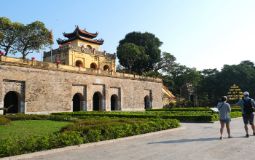
Southeast gate of Hanoi, circa 1888 – 1891 (Source: EFEO).
The exhibition is the first time to exploit the richness and diversity of the documents of the Chau dynasty in the Nguyen Dynasty combined with French documents including images, maps and drawings of Thang Long citadel in Hanoi to reflect the overview. , vivid, true about the process of building, changing the spatial structure into Thang Long – Hanoi under the Nguyen Dynasty and the French influence (1802 – 1945); Confirming more about the value of Thang Long Imperial City Center in terms of architectural art, construction techniques, urban planning.
Under the Nguyen Dynasty, Thang Long – Hanoi no longer held the position of the center of the country, but it still plays an important political role. In 1802, King Gia Long established Thang Long citadel as the capital of Tran Bac city, managing 11 internal and external towns (Tonkin). King Gia Long kept the name Thang Long but changed the word Long in the meaning Dragon to Long in the meaning of Prosperity.
In 1804, Kinh Thien Palace, a famous and typical architectural work of the Le Dynasty, became the main place to place the supply of the Nguyen kings whenever they traveled to the North. For many years later, the supply in Thang Long was constantly repaired. In 1841, Thieu Tri King allowed to build more constructions including a 5-room main hall and a post-electricity, Thi Trieu, Can Chanh and Chu Tuoc gates. Around the palace has a protective wall. Until the 70s of the nineteenth century, the palace was reflected quite clearly in the records, photographs and ancient maps drawn by the French and this was considered “one of the masterpieces of Annam architecture” .
In 1831, Emperor Minh Menh carried out administrative reform, dividing provinces throughout the country, including Hanoi. Thang Long citadel became the headquarters of Hanoi province.
Thang Long Citadel – Hanoi was built by the Nguyen Dynasty in the style of Vauban, on the foundation of the old citadel of the Le Dynasty. This type of stronghold originated in France and was brought to Vietnam in the late eighteenth century. Into a square, circumference of more than 1285 cadre (about 5 km). The walls are taller than 1 staff (about 4 m), 4 m thick (about 16 m) thick, built of green stone and laterite and below with box bricks. The gate is open 5 doors: north, east, west, southeast and southwest.

The Divine Worship of the Cabinet on July 17, the first Thieu Tri (1841) on the appointment of the Prefect and the Governor prepare for the state ceremonies and the reception of royal values to the citadel of the North next year. (Source: National Archives Center I / fonts of the Nguyen Dynasty)
Entering the second half of the nineteenth century, in the complex context of the world and the region, the Nguyen government faced the conspiracy of aggression from the French colonialists. After capturing Cochinchina, from 1873 to 1882, the French colonialists twice invaded Hanoi with the ambition to invade Hanoi as well as Tonkin, master the Red River, convenient for trade with China. Quoc. The Peace-Mang treaty (1883) signed between the Nguyen court and the French was the result of that conspiracy.
Hanoi Citadel during this period (1883 – 1897) was deeply influenced by the French army. In the early years after the capture of Hanoi, the French army took advantage of the old buildings and built more military barracks in the city as the headquarters. However, on July 28, 1893, the Hanoi City Council (established in 1888) proposed to demolish the walls, and the western half of the city, to build a new European-style neighborhood. The plan to demolish and destroy Hanoi was completed in 1897.
From 1897 until 1945 and before the French withdrawal from Hanoi in 1954, the Hanoi citadel area was the headquarters of the French army in Indochina.
Hanoi Citadel is currently a part of the central axis of the ancient Vauban citadel, including: Ky Dai, Doan Mon, Dien Thien, Hau Lau (Tinh Bac floor) and Cua Bac. Along with archaeological remains discovered at the 18 Hoang Dieu area, this site was honored by UNESCO as a world cultural heritage site in 2010.
Exhibition “Hanoi Castle – A Time Mark” has 2 topics:
- Part 1: Nguyen Dynasty with Thanh Hanoi
- Part 2: The French and the Hanoi Castle
The exhibition gives visitors a lot of useful information as well as a better understanding of the value of different types of world heritage, unique of Vietnam.
The exhibition was introduced at Thang Long Imperial Citadel Heritage Area, No. 19 Hoang Dieu, Ba Dinh, Hanoi; Open to visitors from November 22, 2019.













